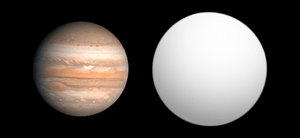HAT-P-14b
| Exoplanet | List of exoplanets | |
|---|---|---|
 | ||
| Parent star | ||
| Star | HAT-P-14 | |
| Constellation | Hercules[1] | |
| Right ascension | (α) | 17h 20m 27.8775s[2] |
| Declination | (δ) | +38° 14′ 31.911″[2] |
| Apparent magnitude | (mV) | 9.98 |
| Distance | 820±60[2] ly (250±20[2] pc) | |
| Spectral type | F | |
| Mass | (m) | 1.386 ± 0.045 M☉ |
| Radius | (r) | 1.468 ± 0.054[3] R☉ |
| Temperature | (T) | 6600 ± 90 K |
| Metallicity | [Fe/H] | 0.11 ± 0.08 |
| Age | 1.3 ± 0.4 Gyr | |
| Orbital elements | ||
| Semi-major axis | (a) | 0.06062+0.00065 −0.00067[4] AU |
| Eccentricity | (e) | 0.1074+0.0076 −0.0079[4] |
| Orbital period | (P) | 4.627682±0.000003[5] d |
| Inclination | (i) | 83.50±0.30[6]° |
| Time of transit | (Tt) | 2455268.64237±0.00031[5] JD |
| Physical characteristics | ||
| Mass | (m) | 2.303±0.054[4] MJ |
| Radius | (r) | 1.150±0.052[6] RJ |
| Discovery information | ||
| Discovery date | 2010-03-10 | |
| Discoverer(s) | HATNet Project[6] | |
| Discovery method | Transit | |
| Discovery status | confirmed[6][7] | |
| Database references | ||
| Extrasolar Planets Encyclopaedia | data | |
| SIMBAD | data | |
| Exoplanet Archive | data | |
| Open Exoplanet Catalogue | data | |
HAT-P-14b is an extrasolar planet located approximately 250 parsecs (820 ly)[2] away in the constellation of Hercules, orbiting the 10th magnitude F-type star HAT-P-14. This planet was discovered in 2010 by the HATNet Project using the transit method.[6] It was independently detected by the SuperWASP project.[7]
Orbit
HAT-P-14b is located very close orbit to its star, taking only 4.6 days to complete one orbit. Observations of the Rossiter–McLaughlin effect with the Keck telescope show that it orbits in a retrograde fashion relative to the rotation axes of its parent star.[3]
References
- ↑ Roman, Nancy G. (1987). "Identification of a Constellation From a Position". Publications of the Astronomical Society of the Pacific. 99 (617): 695–699. Bibcode:1987PASP...99..695R. doi:10.1086/132034. Vizier query form
- 1 2 3 4 5 Brown, A. G. A; et al. (2016). "Gaia Data Release 1. Summary of the astrometric, photometric, and survey properties". Astronomy and Astrophysics. 595. A2. arXiv:1609.04172. Bibcode:2016A&A...595A...2G. doi:10.1051/0004-6361/201629512. Gaia Data Release 1 catalog entry
- 1 2 Winn, Joshua N.; et al. (2011). "Orbital Orientations of Exoplanets: HAT-P-4b is Prograde and HAT-P-14b is Retrograde". The Astronomical Journal. 141 (2). 63. arXiv:1010.1318. Bibcode:2011AJ....141...63W. doi:10.1088/0004-6256/141/2/63.
- 1 2 3 Bonomo, A. S.; et al. (2017). "The GAPS Programme with HARPS-N at TNG . XIV. Investigating giant planet migration history via improved eccentricity and mass determination for 231 transiting planets". Astronomy and Astrophysics. 602. A107. arXiv:1704.00373. Bibcode:2017A&A...602A.107B. doi:10.1051/0004-6361/201629882.
- 1 2 Nascimbeni, V.; et al. (2011). "TASTE: The Asiago Search for Transit timing variations of Exoplanets. I. Overview and improved parameters for HAT-P-3b and HAT-P-14b". Astronomy and Astrophysics. 526. A85. arXiv:1011.6395. Bibcode:2011A&A...527A..85N. doi:10.1051/0004-6361/201015199.
- 1 2 3 4 5 Torres, G.; et al. (2010). "HAT-P-14b: A 2.2 MJ Exoplanet Transiting a Bright F Star". The Astrophysical Journal. 715 (1): 458–467. arXiv:1003.2211. Bibcode:2010ApJ...715..458T. doi:10.1088/0004-637X/715/1/458.
- 1 2 Simpson, E. K.; et al. (2011). "Independent Discovery of the Transiting Exoplanet HAT-P-14b". The Astronomical Journal. 141 (5). 161. arXiv:1009.3470. Bibcode:2011AJ....141..161S. doi:10.1088/0004-6256/141/5/161.
External links
![]()
- "HAT-P-14 b". Exoplanets.
- "HAT-P-14b in transit". Light curve using differential photometry.
Coordinates: ![]()
This article is issued from
Wikipedia.
The text is licensed under Creative Commons - Attribution - Sharealike.
Additional terms may apply for the media files.